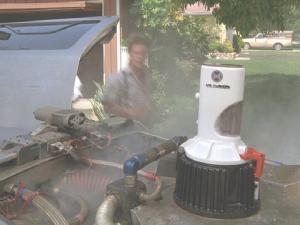A fusion-propelled time machine?
In July 1985, four months before Ronald Reagan and Mikhaïl Gorbatchev met in Geneva and decided to launch the ITER Project, Universal Studios released the first part of the "Back to the Future" film trilogy. What's the connection between these two apparently unrelated events? Well, it's fusion!
The film, which has since achieved cult status, was about the hazards and paradoxes of time travel, about teenage romance, both in 1955 and 1985, and the friendship between the eccentric scientist Emmet "Doc" Brown and a high-school student named Marty McFly.
The time machine Doc had conceived was a modified DeLorean, an elegant stainless steel-panelled, gull-winged sports car, which was actually produced between 1981 and 1982. In the last sequence of the film, when Doc comes back from a "different future" to pick up Marty who has just returned from 1955, we get a brief glimpse of one of the components in the DeLorean's engine: a device somewhat like a coffee maker called "Mr Fusion, Home energy reactor."
We see Doc fumbling in a garbage can, finding some banana peels and leftover beer, and feeding them into the open "reactor." That is apparently all the fuel "Mr Fusion" needs to zap the DeLorean back or forward in time.
A quarter of a century later, one can retrieve more than 32,000 pages when browsing for "Mr Fusion" and "Back to the Future." The exotic device which propelled the DeLorean time machine, using banana peels and lager beer, has fascinated two generations of fans. "In many ways it represents the ultimate dream of all fusion visionaries," one author comments in a blog called Strange Horizons: "Cheap, easy, readily available energy that can easily generate the gigawatts needed for many applications—even breaking the time barrier."
The French TV channel M6 will broadcast the last part of the "Back to the Future" trilogy this Thursday, 5 February, at 8:45 p.m.



